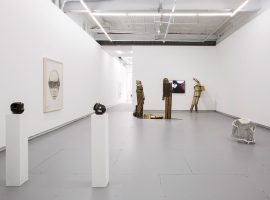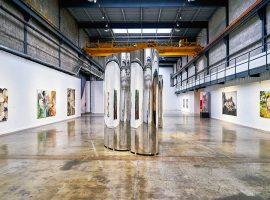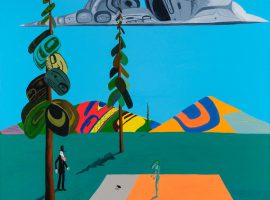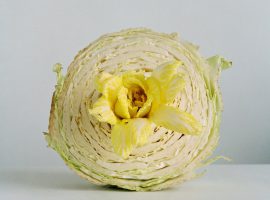
The New Ice Age
Douglas Coupland
Arsenal Contemporary is delighted to present The New Ice Age, twenty-three new paintings by Douglas Coupland, in collaboration with Daniel Faria Gallery, Toronto. The exhibition runs from September 6 to October 19, 2024.
Douglas Coupland is among Canada’s most notable and eminent cultural exports. A best-selling author, he has published fourteen novels—including Generation X (1991), Microserfs (1995), and JPod (2006)—, eleven non-fiction titles, four anthologies, and he has written and performed for England’s Royal Shakespeare Company. Coupland is similarly accomplished and widely exhibited as a visual artist with a robust collector base. His work has been the subject of 35 solo exhibitions, such as large mid-career surveys at the Vancouver Art Gallery (2014), at Witte de With in Rotterdam (2015), and at Villa Stuck in Munich (2016). His curatorial practice in collaboration with Hans-Ulrich Obrist and Shumon Basar has produced a trilogy of exhibitions: The Age of Earthquakes at ICA London (2015); The Extreme Present, Fondazione Prada, Milan (2018); Age of You, MOCA Toronto (2019). Recently, Coupland has put writing and curating aside to focus exclusively on painting with a fresh, surprising, and sharp political content. Lush and complex, his new works have a penetrating physical presence.
Various types of wit are at play in Coupland’s new paintings of icebergs. The formal wit of his compositions—shape, color, texture—takes the viewer from the elegant to the boisterous; from sober stylized monochromes where the iceberg subject is still evident, to an absurd polychromy where it is lost to color and form. Then, there’s the wit of their ‘hard-edge’ facture, of how they were made with brushed paint to emulate collage more than their nominal subject. We can easily imagine different patterned fragments, cut and glued together in a jury-rigged composition of modernist shards, remotely reminiscent of monumental crystals set against ground and sky. Each iceberg on Coupland’s formalist spectrum is anchored to a horizon line, forestalling its ultimate dissolution into non-objective abstraction.
Despite their allusions to other media, these are paintings first. Eventually, Coupland’s icebergs become the signs suggested by their titles, engaging the elegiac wit of the melting subject. A devastating loss to our planetary ecosystem, icebergs cannot evade pathos today; the merrier the artist depicts them, the more biting is the sarcasm. There is a mawkish, ‘sad clown’ tone to Coupland’s reductivist icebergs, whereas the elegy darkens, ironically, with the livelier maximalist examples, becoming more mercenary, like a party dress on a corpse. Then there is the idiomatic wit of their abstract style, a parody of non-objectivity that might recall pictures from old motel rooms or mid-century cocktail lounges. Abstract in style, though not in substance, these qualify the ecological tragedy with a happy resignation that satirizes our largely rhetorical efforts to arrest global warming.
As for Coupland’s signature ‘wit of reference,’ his pictures nod approvingly to the occult satires of Rodney Graham’s late abstractions, and to the work of the earlier B.C. Binning, an influential mid-century painter from Coupland’s native British Columbia whose early abstractions were inflected with a nautical theme. Binning’s thematic formalism is not unlike Marsden Hartley’s Berlin pictures of 1913-15, haunted by German military regalia. And, of course, the pictures refer again to the Canadian modernist Lawren Harris, whose 1930 and 1931 expeditions to the arctic produced some of his most reductive works, painted shortly before he abandoned landscape painting for non-objectivity. Coupland has been reinterpreting Harris’s icebergs for almost a decade, as compulsively as Picasso reprised Velasquez with his 58 versions of Las Meniñas. In fact, we can track a metamorphosis in the artist’s artistic personality through the evolution of this single borrowed subject: from the flat, raucous, computer designs of 2015, to this year’s rich, painterly studio inventions.
Coupland’s The New Ice Age is no ice age at all but an artist’s warning in the guise of a consolation. Despite the series’ multi-dimensional wit, its often searing satire of modernist optimism, and his various art historical evocations, these pictures manage to be both beautiful and new.
Marc Mayer






